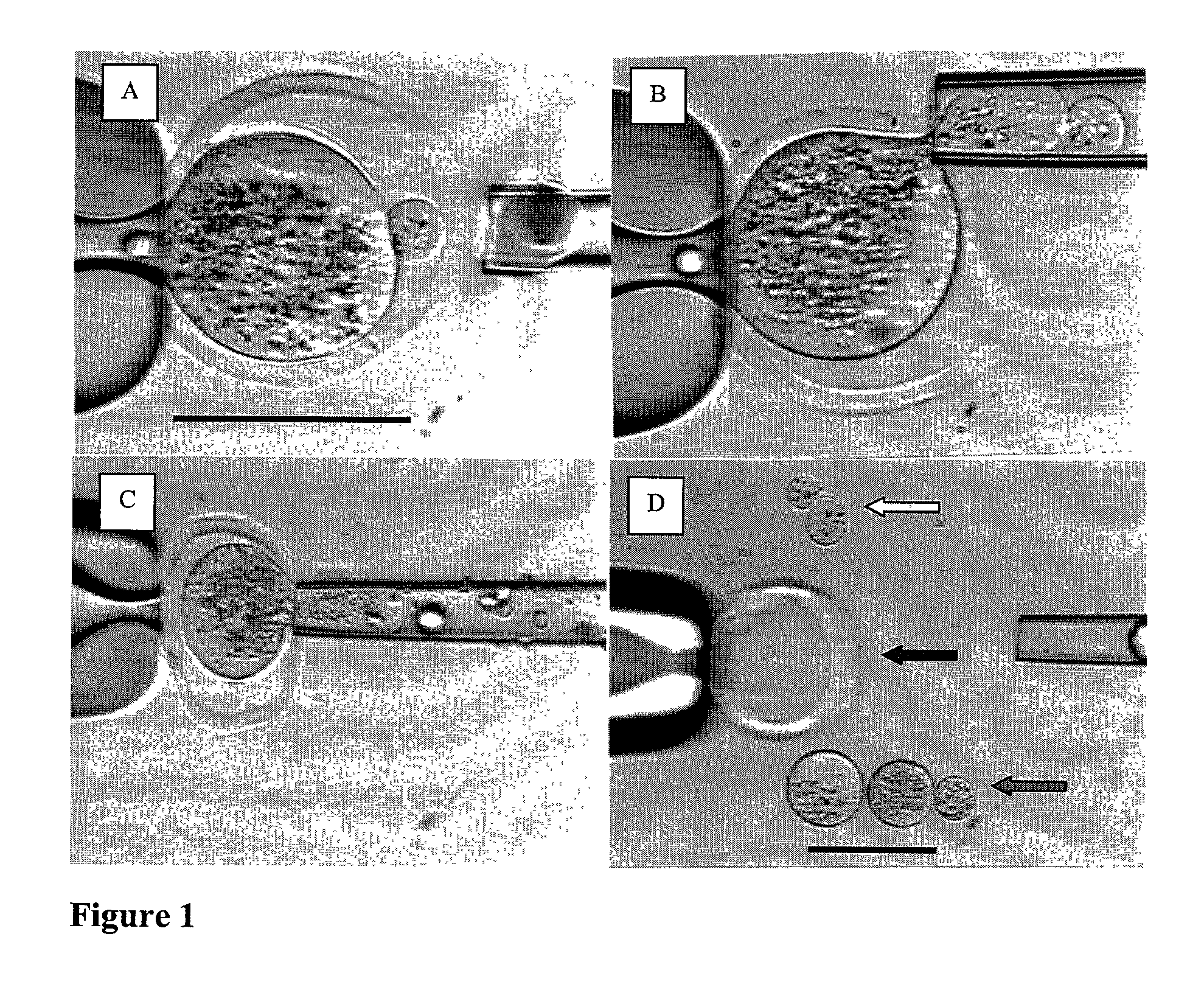Pluripotent stem cells derived without the use of embryos or fetal tissue
a stem cell and embryonic technology, applied in the field of embryonic stem cells, can solve the problems of only obtaining pluripotent es cells, slowed the study of such cells and their application, and substantial risks of immune rejection
- Summary
- Abstract
- Description
- Claims
- Application Information
AI Technical Summary
Benefits of technology
Problems solved by technology
Method used
Image
Examples
example ii
[0387] Micromanipulation and Enucleation of Bovine Oocytes
[0388] Micromanipulation and enucleation of bovine oocytes was performed as follows. Micromanipulation was performed on a inverted microscope (Nikon, Japan) using micromanipulators (Narashige, Japan). The mature metaphase II oocytes were introduced to HECM containing 10% Plasmanate and 7.5-15.0 .mu.g / ml cytochalasin B (Sigma C6762). Next, a holding micropipette (Humagen, Charlottesville, Va.) was used to grasp the oocytes. While holding the oocyte, the zona pellucida of each oocyte was partially dissected (dissolved) by application of an acidic tyrodes solution (Sigma T1788). The acidic tyrodes solution was applied using a 20-30 .mu.m diameter micropipette (Humagen, Charlottesville, Va.). The zona was dissolved adjacent to the polar body of the mature oocyte. Following breach of the zona, a 20-50 .mu.m micrometer polished micropipette (Humagen, Charlottesville, Va.) was used to gently aspirate the polar body and underlying cy...
example iii
[0389] Ooplastoid Generation from Bovine Oocytes
[0390] Ooplastoid generation for bovine oocytes was performed as follows. Enucleated oocytes were introduced to HECM containing 10% Plasmanate and 7.5-15.0 .mu.g / ml cytochalasin B. A micromanipulator (Narashige, Japan) was used to manipulate the enucleated oocytes. A holding micropipette (Humagen 10MPH-120, Charlottesville, Va.) was used to grasp and orient the enucleated oocytes. A 20-50 .mu.m polished micropipette (Humagen custom, Charlottesville, Va.) was used to gently aspirate and pinch off a portion of the enucleated oocyte. This process was repeated until each enucleated oocyte was partitioned into 3-5 zona pellucida free ooplastoids having from 20 to 33% of the volume of the original oocyte. This procedure was repeated until each enucleated oocyte was appropriately partitioned into ooplastoids. Ooplastoids were washed in HECM with 10% Plasmanate to remove Cytochalasin B for further micromanipulation.
example iv
[0391] Preparation of Bovine Somatic Cells for Nuclear Transfer
[0392] The source of bovine somatic cell nucleus for experiments described here has been granulosa cells. Granulosa cells were obtained from bovine oocyte / granulosa masses. The granulosa masses were subjected to chemical treatment with 0.5-1.0 mg / ml hyaluronidase (Sigma H3757) followed by mechanical removal of granulosa through repeated pipetting of the cells using fine bore Pasteur pipettes. Subsequently, the isolated granulosa cells were washed with HECM with 10% Plasmanate to remove hyaluronidase. Next, granulosa were cultured in ECM or HECM supplemented with 10% FCS or Plasmanate in preparation for further micromanipulation. Alternatively, granulosa or any other type of somatic cell may be cultured in ECM supplemented with 0.5% fetal calf serum or Plasmanate for 24 to 72 h to induce quiescence prior to nuclear transfer.
PUM
| Property | Measurement | Unit |
|---|---|---|
| Fraction | aaaaa | aaaaa |
| Fraction | aaaaa | aaaaa |
| Fraction | aaaaa | aaaaa |
Abstract
Description
Claims
Application Information
 Login to View More
Login to View More - R&D
- Intellectual Property
- Life Sciences
- Materials
- Tech Scout
- Unparalleled Data Quality
- Higher Quality Content
- 60% Fewer Hallucinations
Browse by: Latest US Patents, China's latest patents, Technical Efficacy Thesaurus, Application Domain, Technology Topic, Popular Technical Reports.
© 2025 PatSnap. All rights reserved.Legal|Privacy policy|Modern Slavery Act Transparency Statement|Sitemap|About US| Contact US: help@patsnap.com



